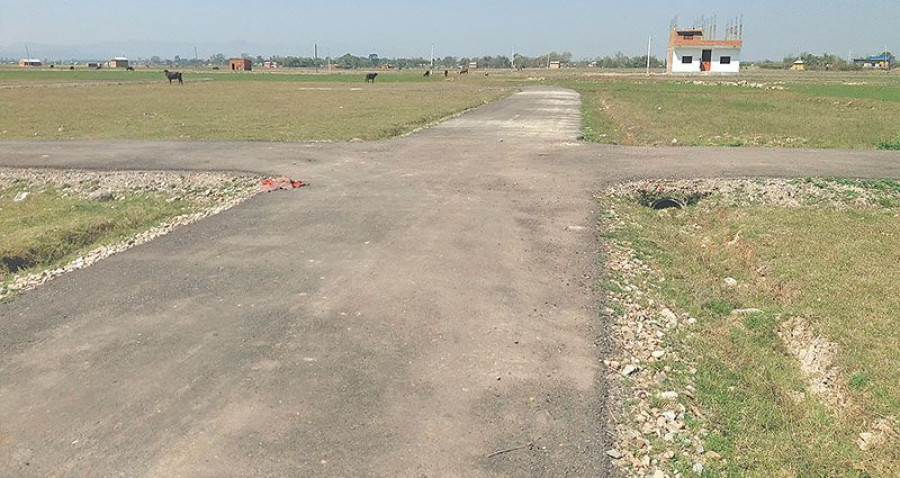National
The western Tarai is urbanising rapidly and all at the expense of agricultural land
The rapid expansion of urban areas into arable land can have serious consequences for food security and environmental sustainability, concludes a new study.
Chandan Kumar Mandal
Ghanshyam Pandey recalls growing up in a Tulsipur that was markedly different from what it has now become. In the 70s, the town in western Nepal was a fraction of the size it is now. It was quiet, peaceful and surrounded by farmland.
“Except for the core area, the entire city was surrounded by agricultural land,” recalled Pandey, who is Tulsipur’s mayor.
Read: Arable land is shrinking, and so is paddy cultivation
Decades since then, the population in Tulsipur, now a sub-metropolitan city, exploded, leading to a corresponding increase in the city area and its buildings. In the 90s, the restoration of multiparty democracy turned the city into a business hub and the decade-long armed conflict saw a massive migration of people from the hill districts down to the city, according to Pandey.
“The cities expanded into its periphery. Land prices rocketed and urbanisation encroached on all the agricultural land,” said Pandey.
Tulsipur, a city in Dang district, is a microcosm of a phenomenon that is taking place all over the Tarai. Cities across the plains are rapidly urbanising and expanding at the expense of arable land, according to a new study published in the journal Remote Sensing.
The study, published last week, analysed land use in the western Tarai, focusing on around 19,200 sq km in the nine districts of Chitwan, Nawalparasi, Rupandehi, Kapilbastu, Dang, Banke, Bardiya, Kaliali, and Kanchanpur. Using landsat satellite imagery, a team of researchers examined urban expansion from 1989 to 2016, concluding that urban cover quadrupled from 71.36 sq km in 1989, to 327.26 sq km in 2016, expanding by nearly 256 sq km [460 percent]”. Thus urban expansion was “almost entirely at the expense of agricultural conversion”.
“After analysing urban expansion in western Nepal, we have found that urbanisation has been rapid and haphazard,” Bhagwat Rimal, lead author of the study, told the Post. “The expansion in the western Tarai was due to many factors, with a major reason being migration from the hilly districts.”

According to the study, the highest rate of urbanisation over the period of study occurred between 2006 and 2011. This expansion largely took place in smaller settlements at the peripheries of major urban centres and along major road networks, primarily along the East-West Highway and North-South Highway.
The rapid urbanisation was largely fueled by population growth in the western Tarai, with the area growing from 3.2 million people in 1991 (17 percent of the national population) to 5.3 million (20 percent) in the 2011 national census.
However, the major cause for concern behind the rapid urbanisation comes from the fact that 249 sq km of agricultural land was lost to urbanisation.
“Such unplanned loss of prime agricultural lands in Nepal’s fertile Tarai region is of serious concern for food-insecure countries like Nepal,” says the study.
According to Rimal, who is a geographer by profession, such a massive increase in urban territory can have negative consequences for food security and environmental sustainability.
“The impacts of this rate of urbanisation are evident in the loss of prime agricultural land,” said Rimal. “Fragmentation of land has occurred in Tarai region where our study was based. The loss could be forests if this kind of urbanisation was reported in the hill districts.”
The researchers found that extensive areas of agricultural land were converted into urban areas in Kailali, Banke, Dang, Rupandehi, and Chitwan districts.
Nepal is one of the least urbanised countries in the world, but it is urbanising at a rapid pace, placing Nepal among the fastest urbanising countries in the world. In 2018, about 19.74 percent of the country’s total population lived in urban areas.
While the loss of agricultural land to urban cover has also been observed in the past, the new study projects a similar trend for the future. According to the research findings, after 2016, urban expansion is predicted to increase by a further 199 sq km by 2026 and by another 165 sq km by 2036—again almost all at the expense of agricultural land.
“We have also examined urban expansion prospects for the future and found that rapid urban growth and agricultural loss will continue largely unabated,” said Rimal. “Such extensive loss of prime agricultural lands in the country’s fertile Tarai region is of serious concern. It further indicates the need for sustainable urban planning.”




 11.12°C Kathmandu
11.12°C Kathmandu















